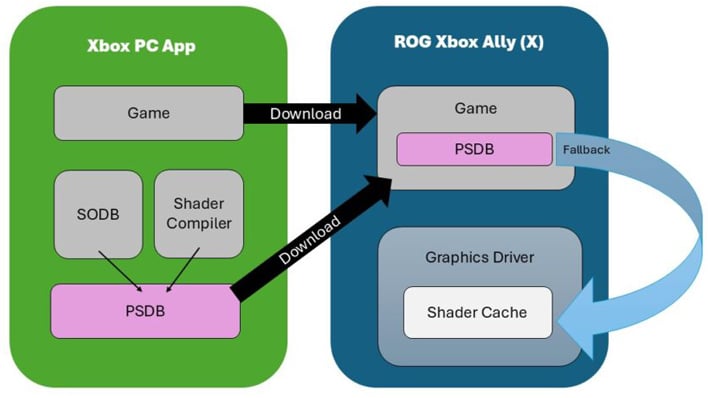DirectX Advanced Shader Delivery Cuts Game Load Times And Targets Steam Deck
We're all quite familiar with the status quo where you fire up your favorite game, and it takes unexplainably long to load up, even though you have a souped-up PC with a fancy NVMe solid state drive and gobs of CPU power. That's usually shader compilation happening, pieces of GPU code that modern game engines need, but that unfortunately depend on your graphics card, driver version, and even graphics settings -- meaning there are hundreds of thousands of possible combinations, if not more. This compilation can also happen within the game, with the all too-familiar random stuttering we've come to know and hate.
In a blog post, the DirectX folks describe how they're taking initial steps to fix this issue with Advanced Shader Delivery, taking games' compiled shaders and storing them in a special format called a State Object Database. Since the shaders are driver-dependent, that database is processed to split off the shader compiler from the graphics driver and create a Precompiled Shader Database (PSDB).
This gets uploaded to Microsoft's cloud servers and downloaded by similar devices via the Xbox app. When your game loads, it'll download the PSDB and avoid lengthy load times and mid-game stuttering. As an example, Microsoft says this technique reduced load times in Avowed by 85%, and points to battery life improvements as an additional benefit. The PSDB can also be updated when a new graphics driver version is released.

If this sounds too promising to be true, it's worth noting that the feature won't yet be universal. The DirectX engineers worked with teams at ASUS, Xbox and AMD to implement this feature for the ROG Xbox Ally and ROG Xbox Ally X, handheld gaming machines based on Windows, but with the Xbox app as a front-end. Microsoft says it'll be releasing its AgilitySDK in September so that developers and storefronts have the necessary APIs and documentation to use this feature. The company also promises "more details on device expansion" in September.
While this is certainly a positive development, we have the feeling that Microsoft is starting to see the Steam Deck as a threat. For now, Valve only needs to support a couple of hardware configurations, and has already implemented a similar feature in SteamOS, though it's still a relatively new thing that most games have yet to implement.
Microsoft is also aping the Steam Deck Verified initiative with its own recommendations for handheld development that marks games as "Handheld Optimized" or "Mostly Compatible". To Microsoft's credit, its verification schema includes a performance metric: an additional "Should play great/well" badge that indicates if the game actually runs smoothly, fixing one of the complaints about the Steam Deck ecosystem.
If Microsoft's ulterior goal is to better compete with the Steam Deck, it'll have a much tougher time, as people use the Deck because it avoids the pitfalls of a full-blown Windows system. Furthermore, while Valve has an Apple-like control over nearly the entirety of the hardware and software stack, Microsoft for now has to rely on third parties to ensure all pieces work in tandem. Having said all that, there's no denying the fact that many popular games, particularly but not only those with kernel-level anti-cheat, just will not run on the Steam Deck, so there's still a marked compatibility advantage for machine running Windows.
There's no word yet on whether Microsoft has plans to expand the shader precompilation to the entire PC ecosystem; it'd certainly be quite the challenge to collect shader code from every possible combination of hardware and software, keep it in a centralized database, and have it distributed to all games and/or their storefronts. One can but hope.

